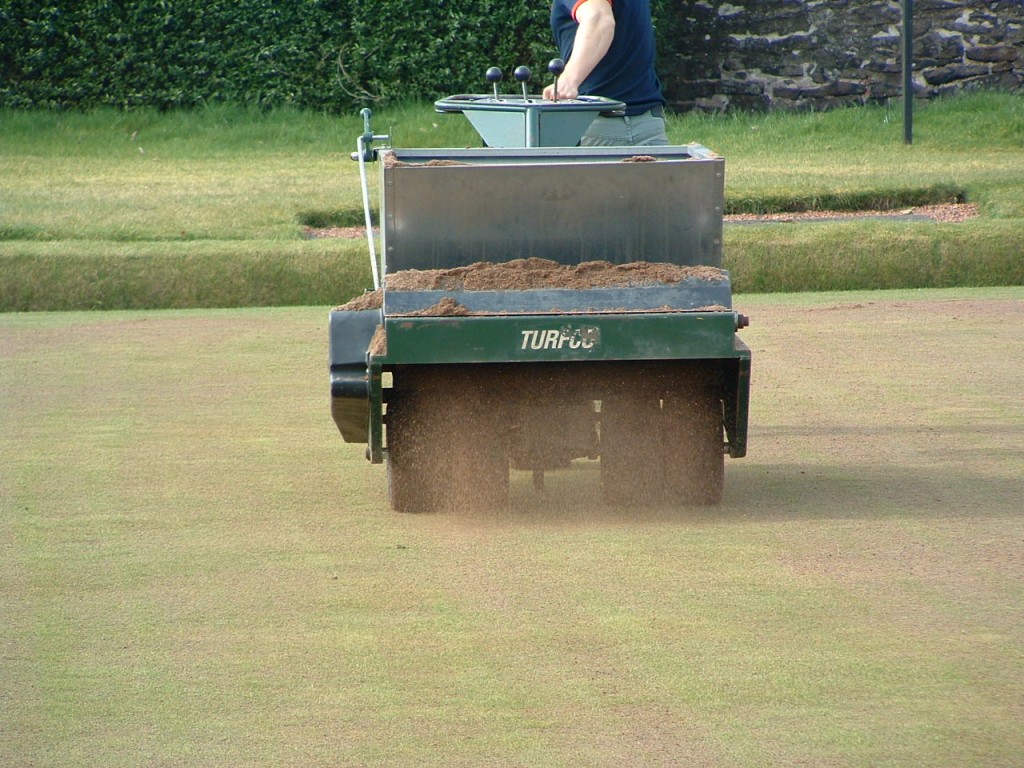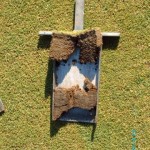Performance turf requires heat and moisture and it is inevitable that you will have to turn to your irrigation system at this time to keep your green’s progress moving forward. Failure to keep up now could result in a disastrous season later on when the green dries out unevenly, succumbs to Localised Dry patch or simply doesn’t perform due to a lack of moisture early in the season.
Tag: critical issues
Feeding the Roses with Pound Notes

I have lost count of the words I have written, conversations I have had and arguments I have inadvertently started about one of greenkeepings greatest follies; routinely top-dressing your green with high sand content top dressing composts year in and year out. During my greenkeeping career over 3 decades and during countless hours of research I have been amazed to find clubs where 5, 7 or even 10 tonnes of top-dressing is being applied every autumn.
The really tragic thing about this practice is that in every case the club are paying for a contractor to hollow tine (core) the green and then apply this material.
Let me ask you where the cores from your green go after they are lifted?
I would hazard a guess that you either spread them on the rose beds around the green or give them away to members for their gardens.
Now hollow tining is typically carried out to a depth of 100mm (4 inches) and usually only 10-15 percent of the core is unwanted thatch.
So that means that 85-90% of each core is made up of all of the expensive top-dressing you have been applying over the years. No wonder the roses look so good!
With top-dressing now costing around £160 per tonne, its easy to see how hundreds of pounds are wasted like this on nearly every bowling green in the UK every year.
In addition to this there are a lot of negative agronomic impacts associated with this practice.
Localised Dry Patch is exacerbated by excessive sand content. This causes areas of the green surface to become impervious to water and dry out completely. The end result is an un-healthy, bumpy green which becomes susceptible to disease, moss infestation and loss of grass cover.
This is just one instance of good money being thrown after bad at just about every bowling green across the land.
Now this is not to say that top-dressing is never required or isn’t a valuable tool in the greenkeepers arsenal. There are times when top-dressing is absolutely the right thing to do.
However, there is generally no need to blindly apply several tonnes every autumn, only to keep the roses looking good!
Performance Basics-Watering the Green

The watering of bowling greens is one of those critical issues in bowling that splits opinion across the game.
Some purists would see no artificial watering of greens regardless of how dry the weather gets. Some are in favour to different degrees; some would argue that the green should only be watered enough to keep it alive, while others demand that the green be watered heavily and often to keep it green.
For me the critical issue is as always performance.
We can argue about the right way to water or not water greens until the cows come home, but green performance is the only measure we should really be worrying about and that means we need to deal with individual greens on an individual basis.
Some greens, mainly those that haven’t been subjected to years of sandy top-dressings dry out evenly across the surface. As the weather gets drier, these greens get faster and smoother and everyone is happy. However, there is a point of no return for these greens also and a complete drought will see them go Read more
Club Turnaround- out of sight out of mind

At this point in the season, when the club is buzzing with life and the match secretary is running around like a decapitated chicken, the bar is busy and there is a general air of optimism…it is easy to overlook the longer term planning needed for club survival and turnaround.
One of the main action points from the Club Success Manifesto was to:
Define your club’s unique position in your community
…there can be no better time to get started on this. If you were a prospective club user or customer or member what would you rather see? A buzzing hive of activity and sociability now, or an empty, poorly heated clubhouse with very little sign of life in the dead of winter?
If your club is struggling, if survival over the coming 5 years isn’t assured, you can’t afford to not be doing this; introducing your club to the wider community and making sure you start the transformation of your club’s fortunes through the softer, people focussed actions, long before you do the easy stuff with trowel and paint brush!
The Manifesto is still available for free here.
Premiership Thinking for a Successful Bowls Club

A BBC2 program “Lord Sugar Tackles Football”, exposed the failures in the English Football Premiership. In a nutshell the program argued that although the creation of the super league of top clubs had resulted in the generation of vast sums of money for football, the overall result has been to create a mountain of debt and indebtedness.
Lord Sugar’s conclusion was that something had to be done about player salaries to stop the rot and that the Premiership should allow one or two high profile clubs to go under to illustrate the dire nature of the situation to the Saturday afternoon faithful, who, after all, actually supply the vast sums of cash being dished out to the top talent.
What on earth has this got to do with your bowling club?
Well although not directly linked (unless of course a Premiership failure would free up some punters to come along to your club next Saturday!) the action required to start the turn around of the premiership’s fortunes is very much the same as that required to turnaround bowling clubs.
Now I know that there aren’t any bowlers, professional or otherwise earning £20,000 a week, but Read more

(s)Top Dressing!
Recent summers have seen a lot of greens devastated by Localised Dry Patch a disorder that is rapidly becoming the scourge of Bowling Green Maintenance Specialists and Club Greenkeepers a like.
I make no apology for writing about this once again, because in my opinion this issue has the ability to accelerate the decline of many already shaky clubs.
It is also clear that there is a deep misunderstanding of the issue across the bowling community…how do I know this?
Well, on several occasions over the last week I have been confronted with some of the worst examples of Localised Dry Patch I have seen in 30 years; in some cases there is virtually no grass cover left and the green surfaces are unlikely to hold together until the end of the season, but…
Despite that, I am still coming up against two of the most mind boggling situations time after time:
- The first is when I am actually demonstrating Localised Dry Patch in action by removing soil samples from affected greens and showing committee members powder dry soil/sand; and they insist that they think the green needs a good top-dressing!
- The second is when I get a phone call or email from a club with the same severe LDP problems who have had a recommendation from an “expert” that they need to top-dress their green to over come the problem.
Listen folks; I know this is turning into a bit of a rant but here are a few bullet points that you must remember if your green and maybe even your club is going to survive:
- Localised Dry Patch (LDP) is a soil disorder not a disease so it can’t be reversed over-night by any quick fix method regardless of how convincing the salesman is!
- LDP has the capability to ruin your green beyond economical repair.
- LDP is so common because clubs have habitually thrown tonnes of sand based top-dressings at their greens for decades; the tipping point has been reached, many clubs are now trying to produce bowling surfaces with limited budgets on very high sand content soils; it can’t be done!
- More sand will only make the problems worse not better.
So what can be done?
Well currently if your green is affected even mildly by LDP and you are in the process of thinking about an autumn program that includes top-dressing with several tonnes of high sand content top-dressing you are not only damaging your green, but you are also wasting hundreds of pounds.
- My eBook Performance Bowling Greens, a practical guide costs less than a bag of fertiliser, so do your green a favour and just buy a copy…its peanuts compared to what you are about to do otherwise.
- In the book there is a clear plan for getting over LDP and moving your green to a consistently high performance surface.
- You will save a lot of cash by taking a more natural, less abusive approach to green maintenance.
- The savings you make could be what saves your club from going under and your green will be on the road to recovery and consistent high performance into the bargain.
If you decide to ignore this, then please take away one message “Stop Dressing”
Thatch Problems

As bowling green maintenance specialists we get lots of questions every week about thatch. So here is a quick crash course on it; what it is, what it does and how to deal with it:
What is it?
Thatch is the name given to the mat of dead roots and shoots that accumulates on the surface of the green. Where moisture, nutrition and cultural practices are optimised for the desired grasses, thatch rarely becomes a problem. However, when soil air content is low, or if drainage is poor and the fertiliser program is not Read more
Your Club Needs You!

I had an interesting conversation with a bowling club official last night that focussed mainly, not on the green for a change, but the club turnaround process that she hopes to take her club through starting soon. Yesterdays post of course, emphasised the urgency of getting started on any project of this nature in the middle of the bowling season; so it was quite fortuitous that this was fresh in my mind, because she asked me a direct question which went some thing like this:
“John. If you were to lead the turnaround of my club, what would you do first and then how would the project pan out after that?”
She was looking for a step by step plan of course that she could apply to her situation.
My answer was emphatic, clear…and mercenary:
Step 1: buy my eBook: Bowling Club Survival and Turnaround; its under a tenner if you are a member of the Bowls Club Mastermind Network and it spells out in 7 easy steps what to do and exactly how to do it.
I was then slightly embarrassed when she said she already had the eBook and that she had read it cover to cover, several times and had made copious notes and was absolutely 100% convinced that it contained the answer to her club’s problems.
The trouble is that she is still having trouble getting what she called “buy in” from the rest of the committee of the club.
“They just can’t accept that decades of slippage, accompanied by the most unpredictable recession in a century, the smoking ban, the cost of living, the general reduction in interest in bowling etc etc could possibly be turned around, let alone by some eBook or other!”
BINGO! I said, that’s it! They are absolutely correct; it can’t be!
Confused looks ensued!
You see my eBook is a series of thoughts, of ideas, of recommendations of which I am convinced, but an eBook alone cannot possibly help your club to get out of its current mess and secure a bright future.
So Step 3 is to implement what you have read in the eBook and that means ACTION!
Step 2 by the way, in case you are wondering, is NOT to tell anyone that you have a new eBook by some geezer on the internet that is going to work miracles for the club!
And that is because it is the enthusiasm of a leader like you; a leader who steps up in a time of crisis, a leader armed with the correct plan and convinced that success is only a bit of blood, sweat and tears away that turns clubs around.
Bowling Club Survival and Turnaround is only the blueprint; it needs an inspired leader to drive home the value of its contents.
There is one such leader tucked away in every club I have ever visited!
Kick Start Your Club Turnaround
Those of you who are working through my Bowling Club Survival and Turnaround eBook will know that I am a stickler for working to a plan and within that “ALWAYS” working on the top 3 issues that will move us closer to our goals.
Some readers have had a bit of difficulty getting traction with their turnaround plans through one problem or another; almost exclusively linked to apathy or inertia within the club or committee, a reluctance to get moving on big change.
For those of you in this category, who feel like they are trying to push water uphill, here is a little system you can use to organise your thoughts and maybe encourage those around you to engage with the plan a little more readily. Its really just about asking 4 simple questions:
What went well last year?
You can easily apply this question to your club situation and come up with
Bowls Club Survival-Action not Words required
 Last year John Woodcock, MP for Barrow-in-Furness has raised a Bill in Parliament to try to prevent bowling greens from being too easily sold off to developers.
Last year John Woodcock, MP for Barrow-in-Furness has raised a Bill in Parliament to try to prevent bowling greens from being too easily sold off to developers.
The current planning laws say that amenity areas like bowling greens should not be zoned for building development if they are being used by a significantly sized group of people.
However, John Woodcock’s Bill aims to provide the facility to tighten these laws to make sure that all reasonable steps are taken to preserve the green; only allowing sale to developers as a last resort. This would include provision to offer greens to user groups first at market rates.
In a radio discussion about the bill there was also an interview with Read more






